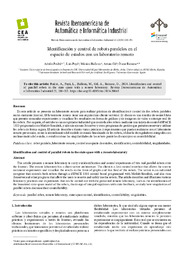Por favor, use este identificador para citar o enlazar este ítem:
https://hdl.handle.net/11000/32891Registro completo de metadatos
| Campo DC | Valor | Lengua/Idioma |
|---|---|---|
| dc.contributor.author | Peidró, Adrián | - |
| dc.contributor.author | Paya, Luis | - |
| dc.contributor.author | Ballesta, Mónica | - |
| dc.contributor.author | Gil, Arturo | - |
| dc.contributor.author | Reinoso, Oscar | - |
| dc.contributor.other | Departamentos de la UMH::Ingeniería de Sistemas y Automática | es_ES |
| dc.date.accessioned | 2024-09-02T10:18:31Z | - |
| dc.date.available | 2024-09-02T10:18:31Z | - |
| dc.date.created | 2024 | - |
| dc.identifier.citation | Revista Iberoamericana de Automática e Informática Industrial 21 (2024) 180-191 | es_ES |
| dc.identifier.issn | 1697-7920 | - |
| dc.identifier.uri | https://hdl.handle.net/11000/32891 | - |
| dc.description.abstract | En este artículo se presenta un laboratorio remoto para realizar prácticas de identificación y control de dos robots paralelos reales mediante Internet. El laboratorio remoto tiene una arquitectura cliente-servidor. El cliente es una interfaz de control Java que permite comandar experimentos y visualizar los resultados en forma de gráficas y de imágenes de video en tiempo real de los robots. Por su parte, el servidor es un computador industrial que controla a los robots mediante una tarjeta de control dSPACE 1103 programada con Matlab/Simulink, y además ejecuta Jimserver y otros programas de gestión que permiten reservar y utilizar los robots de forma segura. El artículo describe e ilustra varias prácticas y experimentos que pueden realizarse con el laboratorio remoto presentado, como la identificación del modelo de estado linealizado de los robots, el diseño de reguladores integrales con realimentación del estado, o estudiar cómo las singularidades de los robots paralelos disminuyen su controlabilidad. | es_ES |
| dc.description.abstract | This article presents a remote laboratory to carry out identification and control experiments of two real parallel robots over the Internet. The remote laboratory has a client-server architecture. The client is a Java control interface that allows the user to command experiments and visualize the results in the form of graphs and live feed of the robots. The server is an industrial computer that controls both robots through a dSPACE 1103 control board programmed with Matlab/Simulink, and also runs Jimserver and other programs that allow the users to reserve and safely use the robots. The article describes and illustrates various laboratory practices and experiments that can be carried out with the presented remote laboratory, such as the identification of the linearized state-space model of the robots, the design of integral regulators with state feedback, or study how singularities of parallel robots decrease their controllability | es_ES |
| dc.format | application/pdf | es_ES |
| dc.format.extent | 12 | es_ES |
| dc.language.iso | spa | es_ES |
| dc.publisher | Universidad Miguel Hérnández de Elche | es_ES |
| dc.rights | info:eu-repo/semantics/openAccess | es_ES |
| dc.rights | Attribution-NonCommercial-NoDerivatives 4.0 Internacional | * |
| dc.rights.uri | http://creativecommons.org/licenses/by-nc-nd/4.0/ | * |
| dc.subject | robot paralelo | es_ES |
| dc.subject | laboratorio remoto | es_ES |
| dc.subject | control en espacio de estados | es_ES |
| dc.subject | identificación | es_ES |
| dc.subject | controlabilidad | es_ES |
| dc.subject | singularidades | es_ES |
| dc.subject.other | CDU::6 - Ciencias aplicadas::62 - Ingeniería. Tecnología | es_ES |
| dc.title | Identificación y control de robots paralelos en el espacio de estados con un laboratorio remoto | es_ES |
| dc.type | info:eu-repo/semantics/article | es_ES |
| dc.relation.publisherversion | https://doi.org/10.4995/riai.2024.20065 | es_ES |

Ver/Abrir:
2024-RIAI-RobotsParalelos.pdf
2,91 MB
Adobe PDF
Compartir:
 La licencia se describe como: Atribución-NonComercial-NoDerivada 4.0 Internacional.
La licencia se describe como: Atribución-NonComercial-NoDerivada 4.0 Internacional.
.png)